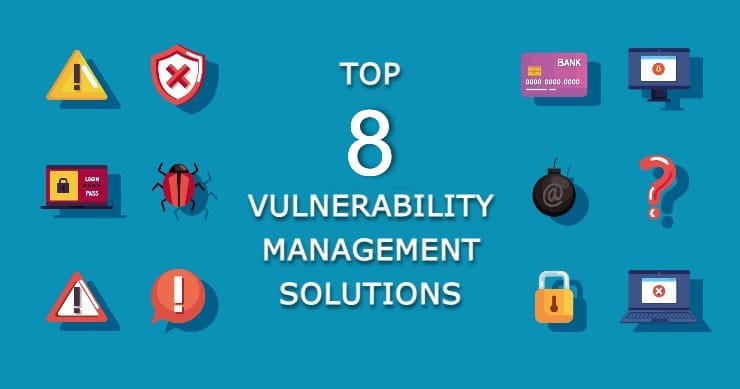How’s your vulnerability management going? Is it effective? Or perhaps you’re doubting yourself, unsure whether your organization is protected against vulnerability-based attacks.
Let’s explore how you can enhance your vulnerability management strategy. We’ll also shortlist the top 8 vulnerability management tools.

What is Vulnerability Management?
Vulnerability management is the process of scanning, identifying, prioritizing, mitigating, and managing vulnerabilities within an organization’s systems and networks.
Vulnerabilities in digital assets can stem from a development-stage coding error in a digital asset. Such was the case with the widespread Log4J vulnerability, a popular Java logging framework. A code error in the Java library allowed hackers to execute malicious code on vulnerable systems remotely.
None of us are perfect. Sometimes, vulnerabilities result from plain old human error. Cloud misconfigurations, such as a misconfigured cloud storage bucket, are common causes of data breaches. In a case like this, an administrator may unintentionally expose sensitive information to the public Internet by failing to implement proper access controls or encryption measures.
Each vulnerability presents a risk, but that risk varies in severity. According to IBM’s X-Force Threat Intelligence Index, vulnerability exploitation is the second most prevalent cyberattack vector. And it’s only getting worse. X-Force also discovered that new vulnerabilities are increasing year over year. In 2022 alone, 23,964 were detected.
Every month, the National Institute of Standards and Technology (NIST) adds over 2,000 new security flaws to its National Vulnerability Database. Last year alone, 29,000 discovered flaws were added to the database. These flaws do not all apply to each entity, but security teams need a method for identifying and resolving those that constitute a potential threat to their systems. That is what the vulnerability management lifecycle is about.
Choosing a Vulnerability Management Solution
The market is heavy with vulnerability management software solutions, each with unique strategies for addressing network threats. Some systems focus on vulnerability identification, while others include sophisticated features for remediation and patching.
And, of course, in 2024, you’ll find solutions that tout technologies such as Artificial Intelligence (AI), Machine Learning (ML), and threat intelligence to augment vulnerability data with contextual insights.
Considering the wide range of options, examining the fine print of vulnerability management systems to guarantee their compatibility with your organization’s requirements and security structure is important.
Let’s explore the leading vulnerability management solutions and analyze their primary features.
Our Top 8 Vulnerability Management Picks
1. InsightVM
InsightVM is a robust cloud-based security vulnerability management solution that complements Rapid7’s on-premises scanner, Nexpose. In addition to scanning and monitoring, InsightVM includes vulnerability tracking, reporting, investigation, and improved remedial capabilities.
Rapid7 InsightVM enables security teams to perform vulnerability assessments across their complete environment (cloud, physical, and virtual infrastructure). The vulnerability management software automatically collects data from all of your endpoints. Administrators can monitor reports using interactive dashboards and supplement results with contextual data. The platform also allows security teams to automate remediation tasks like vulnerability patching and containment. The tool may work with various third-party technologies, such as ticketing systems, patch management solutions, and SIEM tools.
2. Tenable
Tenable enables firms to identify their exposure and vulnerabilities and prioritize which ones to solve first. Tenable’s famous and industry-leading Nessus technology serves as the foundation for the Vulnerability Management product.
Advanced vulnerability scanning proactively detects and monitors all assets on an organization’s attack surface. As it scans, it uses its built-in technology to evaluate vulnerabilities. The platform’s user-friendly dashboard makes analyzing the findings simple.
The platform includes over 200 interfaces that allow you to automate workflows, minimize resource requirements, and expedite issue detection and response. Tenable is a cloud-based solution that is simple to implement and scales with your enterprise.
3. Qualys VMDR
Qualys VMDR (Vulnerability Management, Detection, and Response) enables enterprises to gain greater visibility and insight into their risks, allowing them to understand and mitigate them better. Using the data collected by Qualys VMDR, security teams may prioritize vulnerabilities and assets and take preventive measures.
The cloud-based tool offers various capabilities. It will manage vulnerabilities, detect threats, triage risks, distribute updates, and monitor assets. The platform will continuously scan your network environment for vulnerabilities and notify you as soon as they are discovered. It uses threat intelligence and machine learning techniques to ensure correct threat assessments and triage. When applicable, the platform will immediately deploy a suitable software patch to provide immediate protection against potential hazards.
Because it is a cloud-based platform, Qualys VMDR is simple to implement, scale, and combine with other security solutions such as SIEM.
Start Getting Value With
Centraleyes for Free
See for yourself how the Centraleyes platform exceeds anything an old GRC
system does and eliminates the need for manual processes and spreadsheets
to give you immediate value and run a full risk assessment in less than 30 days
4. Tripwire IP360 by Fortra
Tripwire IP360 is a comprehensive cybersecurity platform designed to enhance overall security posture by identifying and prioritizing potential security risks within IT infrastructure. Key features include advanced scanning capabilities to detect vulnerabilities across various applications and devices, real-time threat intelligence for staying updated on the latest security threats, automated prioritization based on severity and potential impact, and integration flexibility with cloud and on-premise systems.
Tripwire IP360 ensures compliance with regulatory requirements, provides comprehensive network activity monitoring, and offers detailed reporting to track vulnerabilities and monitor security posture effectively.
5. GFI LanGuard
Languard, a network and web application vulnerability scanner from GFI Software, detects and scans devices for missing operating systems and third-party software patches. The program also includes capabilities like security and compliance audits, network modification tracking, report generation, and identifying common security holes.
LanGuard is an excellent solution for deploying patches across remote systems. It has an easy-to-use interface, user-friendly reports, task automation and scheduling, auto-remediation, etc. It also functions as a scanner, looking for software vulnerabilities and misconfigurations.
6. Cisco’s Vulnerability Management
Cisco’s Vulnerability Management platform is a robust solution designed to help organizations prioritize and mitigate cybersecurity risks effectively. It provides comprehensive insight and threat intelligence, facilitating informed decision-making and proactive threat mitigation strategies.
The platform enables organizations to detect vulnerability changes and forecast potential weaponization, allowing them to remediate high-risk vulnerabilities before attackers can exploit them. By sourcing data from over 19 threat intelligence feeds, the platform offers a comprehensive view of emerging threats and shifting trends, enhancing organizations’ understanding of their risk profile. Moreover, the platform serves as a single source of data-verified information for security and IT teams, improving communication and conserving resources.
7. Falcon Spotlight
The CrowdStrike Falcon platform uses real-time indications of attack, threat intelligence, and telemetry from diverse enterprise sources to provide high-grade detection, automated protection and healing, advanced threat tracking, and efficient vulnerability visibility. Designed in the cloud with a lightweight-agent architecture, the Falcon platform offers swift deployment, unique protection and performance, and reduced complexity, delivering significant value from the outset.
8. Frontline Vulnerability Manager
Frontline VM is a comprehensive proprietary network vulnerability scanner that scans online applications and identifies vulnerabilities throughout your network’s portfolio using threat assessment technologies. It can be implemented in the cloud or on-premises.
It takes a risk-based approach to vulnerability assessment, assigning threat levels based on priority (High, Moderate, Low) to each found vulnerability to help you better understand your system’s weaknesses.
The Broad Scope of Vulnerability Management
Confusing vulnerability management with more familiar concepts like firewalls, RMMs, and antivirus programs is common. But they are not the same thing.
Here’s why.
Antivirus software, firewalls, and remote monitoring and management (RMM) platforms are indispensable tools for safeguarding digital assets and maintaining system integrity. However, these tools only partially handle the broader challenge of vulnerability management systems.
Take RMM tools, for instance. They proactively manage networks and endpoints with automated alerts and real-time monitoring. However, their focus remains predominantly on system health.
Similarly, antivirus software, a staple in every organization’s cybersecurity arsenal, plays a vital role in detecting and removing known malware threats. Yet, its reliance on predefined malware signatures limits its efficacy against emerging vulnerabilities and novel attack vectors. Antivirus software operates reactively, responding to known threats rather than proactively identifying and mitigating vulnerabilities.
Firewalls are essential gatekeepers in network security, employing stateful inspection and packet filtering techniques to control network traffic flow based on predefined rules. However, their focus on external threats and packet-level filtering limits their effectiveness in identifying and mitigating internal vulnerabilities within the network. While firewalls excel at preventing unauthorized access, they do not provide comprehensive vulnerability management capabilities.
Because vulnerability management is more comprehensive than firewalls or antivirus software alone, it simply cannot be a “plug-and-play” product. By definition, vulnerability management is a process, not a tool, and employs some basic concepts to determine a strategy for vulnerability management.
The Vulnerability Management Lifecycle
The vulnerability management lifecycle is a continuous process that identifies, prioritizes, and addresses vulnerabilities in a company’s IT assets.
Ensure that each stage of the vulnerability management lifecycle is addressed in a solution.
- Asset Inventory and Vulnerability Assessment
- Prioritize Vulnerabilities
- Vulnerability Resolution
- Verification and Monitoring
- Reporting and Improving
The Power of Vulnerability Management As Part of a Cyber Risk Management Strategy
Integrating a vulnerability management program seamlessly into your entire risk management approach is critical for reaping secure benefits. Manual vulnerability and risk management is no longer possible or efficient in today’s complex ecosystems. Automation is critical to protecting your company’s assets, where Centraleyes excels.
Centraleyes is the world’s most advanced cloud-based integrated risk management solution, revolutionizing risk and remedial management. Our user-friendly dashboard acts as a single hub, collecting real-time threat intelligence from all parts of your ecosystem, including vendors. This holistic picture provides unprecedented insight into potential weaknesses and gaps.
But Centraleyes goes even further. Our comprehensive platform analyzes the received data and creates actionable, prioritized, and efficiently managed remediation activities. Each identified risk is effortlessly integrated into our dynamic risk register, which can be customized and updated.
Schedule a demo today to learn more about Centraleyes.
Start Getting Value With
Centraleyes for Free
See for yourself how the Centraleyes platform exceeds anything an old GRC
system does and eliminates the need for manual processes and spreadsheets
to give you immediate value and run a full risk assessment in less than 30 days






